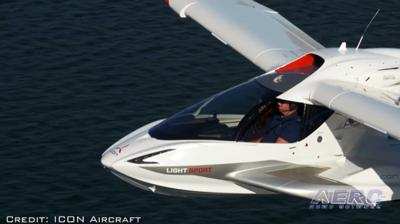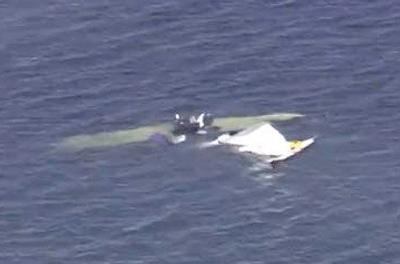The CAP System Was Not Deployed, And The CAP Cockpit Handle Pin Was In Its Installed Position
Location: Clearwater, FL Accident Number: ANC18FA007
Date & Time: 11/07/2017, 1204 EST Registration: N922BA
Aircraft: ICON AIRCRAFT INC A5 Aircraft Damage: Substantial
Defining Event: Loss of control in flight Injuries: 1 Fatal
Flight Conducted Under: Part 91: General Aviation - Personal

On November 7, 2017, about 1204 eastern standard time, an Icon Aircraft A5 special light sport amphibious airplane, N922BA, sustained substantial damage when it was involved in an accident near Clearwater, Florida. The private pilot sustained fatal injuries. The airplane was operated as a Title 14 Code of Federal Regulations (CFR) Part 91 personal flight.
The airplane departed from Island Ford Lake in Odessa, Florida, about 1147. According to data from the Icon digital to analog (DAC) data memory unit that was installed on the airplane, the airplane climbed to a GPS altitude of 1,909 ft and proceeded north for 4 nautical miles (nm) before turning west toward the Gulf of Mexico. The airplane then flew for 10 nm at a GPS altitude of about 600 ft and descended over the gulf before turning south. During the final 3 minutes of the flight, the airplane was traveling in a southerly direction along the shoreline; figure 1 shows the flight track. During the last 2.5 minutes of the flight, the pilot conducted three maneuvers with high angles of attack (AOA) and load factors of almost 2 Gs; at that time, the airplane was over the water at GPS altitudes between 0 and 358 ft. During the final maneuver of the flight, the airplane entered a right turn, the engine power decreased, and the AOA reached 16°. The last recorded data point, at 1203:41, showed that the
airplane's airspeed was 75 knots and heading was 354°.
The airplane was also equipped with a Rotax engine control unit. The last recorded data point, at 1203:43, indicated an engine speed of 2,829 rpm and a throttle position of 27%. Multiple witnesses in the area stated that they saw the airplane flying very low, between 5 and 300 ft, over the water as the airplane maneuvered south close to the shoreline. Some witnesses reported that the airplane was making steep turns and high-pitch climbs up to about 500 ft and that the engine sounded normal. A witness provided an image of the airplane over the water, as shown in figure 2. A commercial fisherman stated that the airplane flew over his vessel at an altitude that was less than 300 ft. Another commercial fisherman, who was located about 900 ft north of the accident site, stated that he observed the airplane flying from the north "really close" to houses. The airplane then flew south past his position, descended briefly, and climbed. After entering a steep climb, the airplane descended on an easterly
heading in a steep nose-down attitude; the airplane's pitch attitude decreased as the airplane continued to descend. The witness reported that the airplane impacted the water in a 45° nose-down, wingslevel attitude.

The pilot had 14.5 hours of total flight experience in the accident airplane. The pilot made an entry into his logbook indicating that, while en route from the Peter O. Knight Airport in Tampa, Florida, to his home, he flew under the Skyway Bridge; the bridge has a 180-ft vertical clearance over the water. Recovered GPS data showed that the pilot flew under the bridge on October 26, 2017. A few days later, the pilot stated on social media, "flying the Icon A5 over the water is like flying a fighter jet!"
Other Details
The airplane came to rest inverted in about 4 ft of water and was oriented on a 192° heading, as shown in figure 4. The empennage was separated and displaced forward of the wings. All major airplane components were located at the accident scene. The front fuselage and cockpit were highly fragmented, with pieces scattered within a 300-ft radius of the main wreckage.
The CAP system was not deployed, and the CAP cockpit handle pin was in its installed position. The fuselage canopy was located about 50 ft west of the wreckage with about 50% of the plexiglass fractured and missing. The left (pilot's) seat was separated from the fuselage. The pilot's three-point harness system was anchored securely to the left wall with the inertia reel intact, secure, and fully operable. The webbing exhibited fraying about 12 inches from the reel.
The seatbelt buckle operated normally and locked in place when the tab was inserted. The wings, wing tips, and nose section exhibited symmetrical fragmentation consistent with a wings-level impact. Both wings were attached and secured in the locked position. Control continuity was established from the cockpit controls to the elevator, which exhibited full movement between stops. The torque tube was bent about 10° near the center; the forward pulley was intact with the bracket separated at the bond. The cables were traced through the system with no fractures. Secondary elevator stops were observed in place near the forward bellcrank. The pitch trim actuator rod remained intact. The pitch trim electrical connector remained attached to the torque tube, and all contact pins were intact.
Control continuity was established from the cockpit to the rudder through separations. The separations were consistent with overload.
Control continuity was also established from the cockpit controls to each aileron. All aileron pulleys displayed impact indentations but exhibited full roll movement. The secondary aileron stops were observed in place. The right wing root aileron bellcrank was displaced inboard about 6 inches from the airframe mount but remained attached to the cables. Both flaps and the flap handle were in the retracted position.

The fuel tank cap was secure, the fuel tank was breached by the engine throttle cable, and no fuel was present. The engine remained attached to the airframe. The engine was manually rotated at the propeller, and continuity and compression were established for each cylinder. The propeller remained attached to the crankshaft. No preaccident anomalies were noted with the airframe or engine that would have precluded normal operation.
Medical And Pathological Information
The Office of the Medical Examiner, District Six, Pasco and Pinellas Counties, Florida, performed an autopsy of the pilot. His cause of death was blunt trauma, and drowning was a contributory condition.
Toxicology testing performed at the Federal Aviation Administration (FAA) Forensic Sciences Laboratory identified the following drugs in the pilot's specimens:
Zolpidem was identified in the pilot's cardiac blood (0.088 µg/ml) and urine. Zolpidem is a sleep aid available by prescription as a schedule IV controlled substance that is often sold with the name Ambien.
The drug information states the following: Complex behaviors such as 'sleep-driving' (i.e., driving while not fully awake after ingestion of a sedative-hypnotic, with amnesia for the event) have been reported with sedativehypnotics, including zolpidem. These events can occur in sedative-hypnotic-naive as well as in sedative-hypnotic-experienced persons. Although behaviors such as 'sleep-driving' may occur with zolpidem tartrate alone at therapeutic doses, the use of alcohol and other CNS
[central nervous system] depressants with zolpidem tartrate appears to increase the risk of such behaviors.

Amphetamine was identified in the pilot's cardiac blood (2.2 µg/ml) and urine. Amphetamine is a schedule II controlled substance that stimulates the central nervous system. It is available by prescription for the treatment of attention deficit disorder and narcolepsy. It carries a boxed warning about its potential for abuse and has warnings about an increased risk of sudden death and the potential for mental health and behavioral changes. In some preparations, the prescription drug is metabolized to amphetamine; commonly marketed names in this category include Adderall, Dexedrine, and Vyvanse. After a single 30-mg oral dose, early blood levels averaged 0.111 µg/ml, and average blood levels in adults using the long-acting prescription orally for a week were about 0.065 µg/ml.
Amphetamine is also prepared and used as a street drug that can be snorted, inhaled, or injected. Generally, levels above 0.2 µg/ml indicate amphetamine misuse to maximize the drug's psychoactive effects.
Morphine was identified in the pilot's cardiac blood (0.192 µg/ml) and urine. Morphine is a powerful opioid pain medication available as an injection, a tablet, or a capsule and is identified as a schedule II controlled substance. Ranges for therapeutic levels are typically determined by giving novice users one or two doses and measuring their blood levels; such ranges are 0.010 to 0.100 µg/ml. With regular opioid use, brain physiology changes, leading to tolerance for both the desired analgesic and sedative effects and resulting in increased dosing.
Chronic users may need the drug to feel and act "normally"; thus, a chronic user may appear to function normally at levels that could be toxic or even fatal to a first-time user. Fluoxetine and its metabolite norfluoxetine were identified in the pilot's cardiac blood (0.984 and 1.569 µg/ml, respectively) and urine.
Fluoxetine is an antidepressant available by prescription. It carries the following warning: As with any CNS-active drug, fluoxetine has the potential to impair judgment, thinking, or motor skills. Patients should be cautioned about operating hazardous machinery, including automobiles, until they are reasonably certain that the drug treatment does not affect them adversely. However, major depression itself is associated with significant cognitive degradation, particularly in executive functioning. The cognitive degradation may not improve even with remission of the depressed episode, and patients with severe disease are more significantly affected than those with fewer symptoms or episodes.
Baclofen was identified in the pilot's cardiac blood (0.72 µg/ml) and urine. Baclofen is a muscle relaxant available by prescription. It carries the following warning: Because of the possibility of sedation, patients should be cautioned regarding the operation of automobiles or other dangerous machinery, and activities made hazardous by decreased alertness. Patients should also be cautioned that the central nervous system effects of baclofen may be additive to those of alcohol and other CNS depressants. Hydromorphone was found in the pilot's urine. Hydromorphone is an opioid pain medication available by prescription as a schedule II controlled substance. Other common names are Dilaudid and Exalgo. Hydromorphone is also a relatively uncommon active metabolite of morphine and a common metabolite of hydrocodone, which is not a metabolite of morphine.
Hydromorphone carries the following warning: Hydromorphone and other Schedule II opioid agonists, including morphine, oxymorphone, oxycodone, fentanyl, and methadone, have the highest potential for abuse and risk of producing respiratory depression. Alcohol, other opioids and central nervous system depressants (sedative-hypnotics) potentiate the respiratory depressant effects of hydromorphone, increasing the risk of respiratory depression that might result in death.
Ibuprofen was found in the pilot's urine. Ibuprofen is an over-the-counter pain medication commonly sold as Motrin and Advil. It is not considered impairing.
No ethanol was detected in the pilot's vitreous specimens.
Review of the available personal medical records for the pilot indicated a history of substance abuse requiring inpatient rehabilitation twice between 2013 and early 2015 and diagnoses of chronic back pain, insomnia, and depression, which were treated with various prescribed medications. The pilot's personal medical records for 2016 and 2017 were not available.
 ANN's Daily Aero-Term (04.25.24): Airport Rotating Beacon
ANN's Daily Aero-Term (04.25.24): Airport Rotating Beacon ANN's Daily Aero-Linx (04.25.24)
ANN's Daily Aero-Linx (04.25.24) Klyde Morris (04.22.24)
Klyde Morris (04.22.24) Airborne 04.24.24: INTEGRAL E, Elixir USA, M700 RVSM
Airborne 04.24.24: INTEGRAL E, Elixir USA, M700 RVSM Airborne 04.22.24: Rotor X Worsens, Airport Fees 4 FNB?, USMC Drone Pilot
Airborne 04.22.24: Rotor X Worsens, Airport Fees 4 FNB?, USMC Drone Pilot


